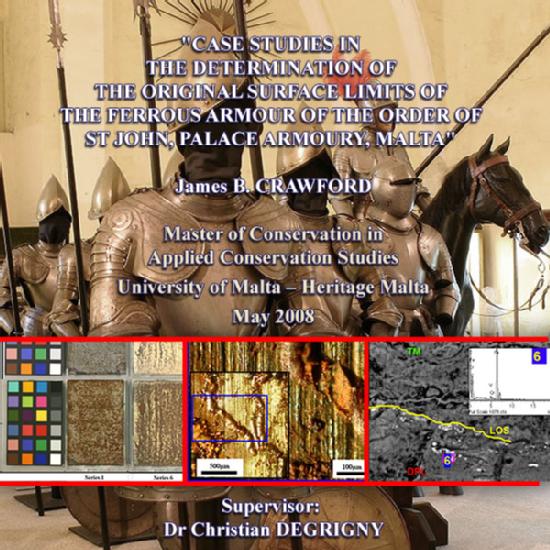James Crawford
Master's dissertation |
Atmospheric corrosion products of iron & low-carbon steel: identifying the location of past metallic surfaces
A dissertation submitted in partial fulfilment of the requirements for the degree of Master of Conservation in Applied Conservation Studies (M. Cons.):
| "Case studies in the determination of the original surface limits of the ferrous armour of the Order of St John, Palace Armoury, Malta"
Supervisor: Dr Christian Degrigny External examiners: Prof David A Scott & Dr Stephen Abela
|
 |
Abstract
Ferrous heritage artefacts either from a burial environment, or in an indoor museum, can be either totally or partly masked by (or even comprised of) corrosion product (CP) layers. Some CP layers reduce surface legibility and corrosion resistance, and possibly contain altered traces of original surfaces. The correct amount of corrosion product cleaning required for all artefact materials and environments is not yet a fait accompli… As Bertholon suggests, “…we must question our attitudes about the cleaning of other archaeological or museum objects” [1]. The way the corrosion products evolve on mid-late Early Modern Period wrought iron and low-carbon steel in an atmospheric environment, and any capability of retaining the limit of the original surface (or limitos after Bertholon [2]), is the topic of this dissertation. This experimental research diagnostically determined the presence of the limitos in atmospherically corroded steel to indicate an appropriate level of CP removal during conservation treatments of historical wrought ferrous artefacts. Specific attention and adaptation of the findings was made to a historically accessible and atmospherically exposed collection: the partly corroded 16th-17th century northern Italian-style wrought iron and low-carbon steel munition armour of the Order of St John, Palace Armoury (PA), Malta.
Non-invasive and non-destructive study of the Palace Armoury’s largely undecorated munition armour collection, and its environment, enabled the deduction of the specific corrosion processes, and the formation of resulting corrosion product morphologies. The information gained from authentic armour was used to corrode quantities of armour analogues (contemporary artefact simulation material) in the laboratory. Destructively studying the resulting corrosion product morphologies determined that markers were present above (e.g. applied particles, protective coating) and corresponding with (e.g. surface marks) the limitos. The limitos on these ferrous surfaces was typified by certain vertically displaced CP morphologies and coherency depended on their formation process and extent of underlying corrosion. Filiform corrosion morphologies always exhibited evidence of the previous metal surface (i.e. topographical micro-grooves) in the raised filaments of its corrosion products. However, local to general corrosion morphologies demonstrated that the limitos was only evidenced with these micro-grooves if the corrosion was during its earliest corrosion phase: as corrosion in the subsurface pit continued, any initially apparent original micro-grooves in the surface became more displaced and were eventually totally deformed and fragmented beyond recognition.
[1] Bertholon, R. (2001). To get rid of the crust or not: emergence of the idea of "original surface" in the conservation of metal archaeological objects in the first half of the 20th century. Past Practice – Future Prospect – The British Museum Occasional Paper A. Oddy & S. Smith (eds.). London, British Museum Press. 5-11.
[2] Bertholon, R. (2000). La limite de la surface d'origine des objets métalliques archéologiques: Caractérisation, localisation et approche des méchanismes de conservation. U.F.R. d'Art et d'Archéologie. Paris, Université Paris 1 Sorbonne-Panthéon.

